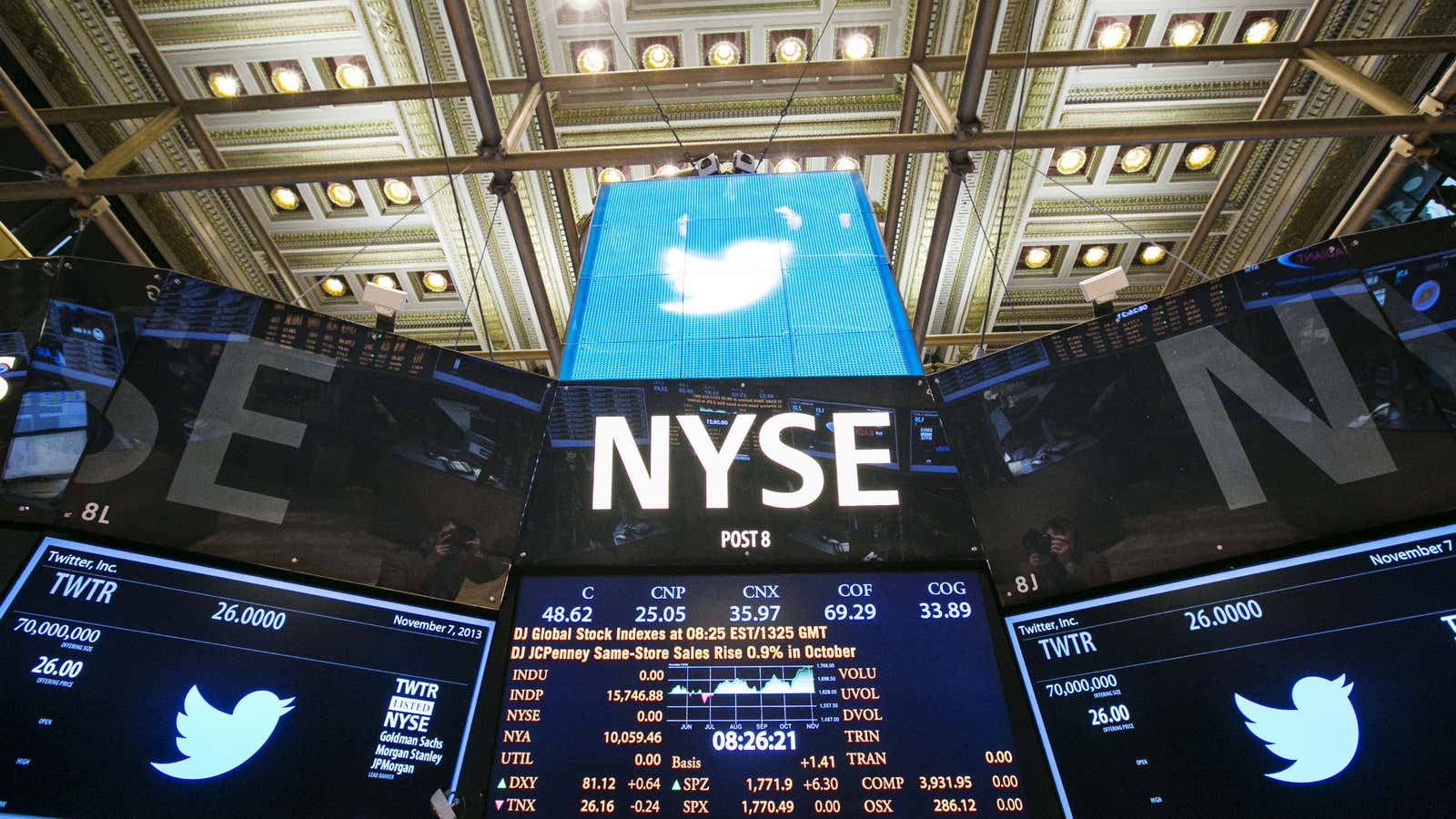“I am not going to be satisfied until we reach every connected user on the planet, period,” Twitter’s CEO Dick Costolo declared at an investor conference last month. Them’s fighting words for any internet company. But especially for Twitter, which has a user growth problem and knows it.
Despite widespread media publicity surrounding Twitter during its triumphant IPO in November, it failed to add meaningfully to its user base during the fourth quarter, and since then questions have begun to mount over its ability to rectify that.
This week, on the eighth anniversary of its founding, we looked at some of the challenges facing Twitter, including the reasons people quit the service. And many do. There are nearly 965 million registered Twitter accounts, according to Twopcharts’ Twitter activity monitor. If those numbers are correct, it means there are three times as many lapsed or dormant Twitter accounts as there are active ones.
Twitter had 241 million monthly active users at the end of 2013, compared with 1.2 billion for Facebook and 200 million for Instagram. Twitter is also growing more slowly than its peers. Cowen & Co predicts that Twitter will reach only 270 million monthly active users by the end of 2014, and that the network will be overtaken by Instagram, which Cowen expects to have 288 million monthly active users by then. The good news is Twitter itself recognizes the problem. But solving it is another matter entirely.
Converting the doubters
Costolo has talked at length about re-engaging with lapsed users, which makes sense, because they look like the low hanging fruit. A recent survey by Deutsche Bank found that nearly 60% of former users would be willing to return to the network, while 47% of people who say they have never used Twitter said there was nothing that would motivate them to try it.
But to understand why people quit Twitter, it’s also worth understanding why people actually do use Twitter. For breaking news and content discovery, according to Deutsche’s charts, below. In other words, not so much for the status updates that co-founder Jack Dorsey envisaged (which sometimes annoy rather than inform).
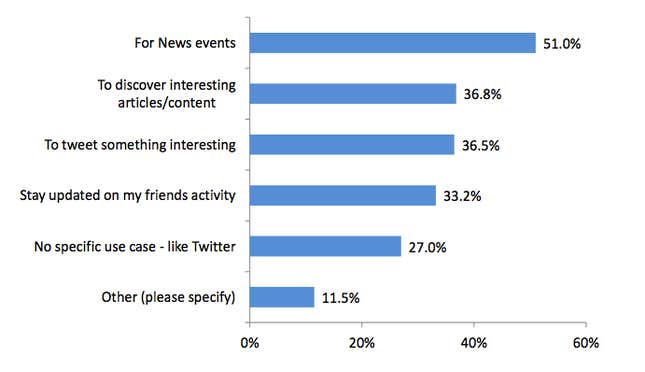
The problem is, lapsed users don’t seem to be able to find the breaking news and interesting content they want, or even if they think they can, information overload prevents them from getting to it. That’s why most lapsed users, according to Deutsche’s survey, say the biggest single factor that would persuade them to return is better sorting and filtering tools.
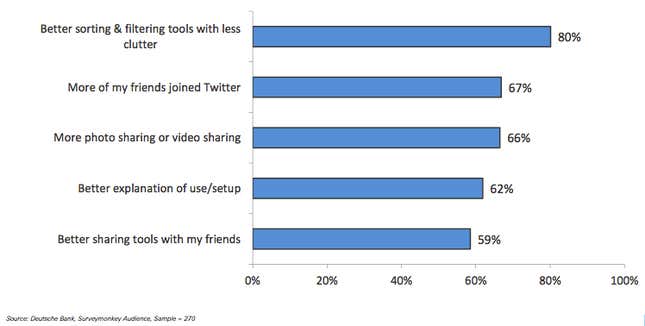
Twitter is painfully aware of these issues. Costolo has talked about simplifying the on-boarding process for new users. The company has described the hashtags and @ symbols used to denote replies as “arcane,” opening the door to the possibility of culling those user-driven features that have characterized Twitter throughout most of its existence. The company has rolled out new features such as push notifications and Event Parrot, which is still in beta testing mode, designed to alert people to breaking news.
It has also tested multiple timelines on Tweetdeck, which are designed to enable easier filtering. And Costolo said the company aims to “do a better job organizing content for our users along topical lines rather than just chronological lines,” with as-yet-undisclosed improvements this year.
But there is no silver bullet. Costolo said on an earnings call that it will be the “cumulative effects” of multiple new features this year that he hopes will revive slowing user growth.
Following back
Many new Twitter users set about finding the right people to follow, but when it comes to retention, helping new users amass their own followers should be Twitter’s focus. According to Deutsche Bank’s survey, most of the people who have tried Twitter and quit had 10 followers or fewer.
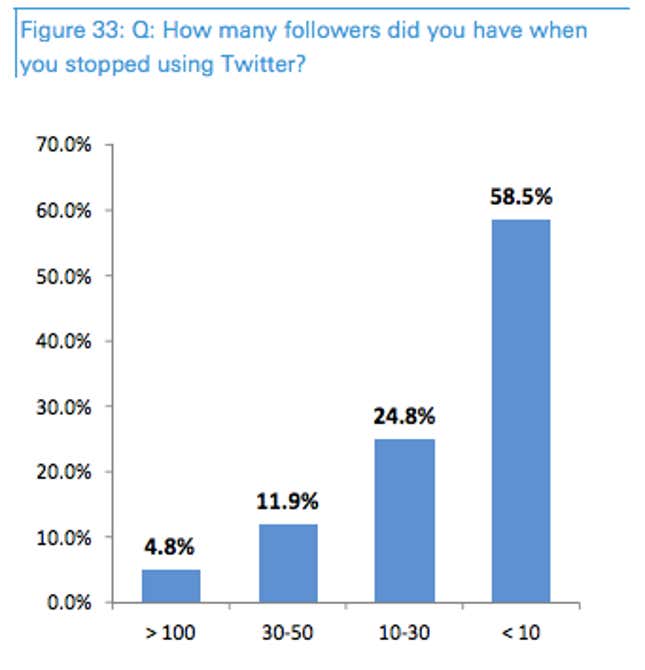
By the same token, Twitter says people who have a reasonable number of “mutual connections” are far less likely to quit than those who don’t. ”Our user research and the data is that when you connect to three or more accounts that follow you back and you can start interacting with each other, you’re much more likely to become a long-term engaged core user of the platform,” Costolo said earlier this year.
This week Twitter rolled out some significant changes that look designed to drive that. It now allows you put up to four photos in a tweet, and tag up to 10 people, without counting against the 140-character limit. The changes make it more likely that a new (or lapsed) user will receive a notification alerting them to the fact that something involving them is happening on Twitter, and prompting them to engage (or re-engage) with the service. But whether these Facebook-like changes will appeal to existing, core users of Twitter remains to be seen.
It’s not about the money
The irony of all this is that Twitter is making serious progress on monetizing its user base, as the chart below from Nomura shows.
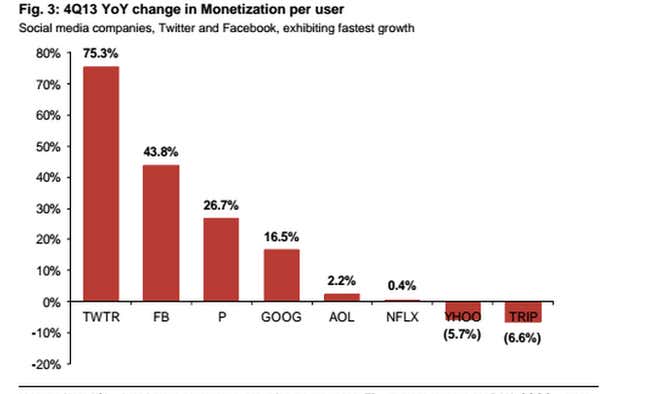
Even if user growth last quarter underwhelmed, revenue was better than expected. Advertising on the service is by definition native—ads are just promoted tweets—and they are effective. “Twitter is increasingly becoming a go-to online ad destination,” Topeka Capital Markets analyst Victor Anthony said in a note this week.
In specific areas such as television, Twitter is making huge inroads. At an event hosted by Quartz earlier this month, Twitter’s head of television, Fred Graver, outlined some of the initiatives the company is working on with the broadcasting industry as it looks to cement its position as the pre-eminent “second screen” app. These included the “SEEiT” feature being trialled by Comcast, which allows users to effectively use their phone as an online remote control: when they see a Tweet about a TV show, they can click on it and immediately watch it or DVR-record it.
Separately, its Amplify service enables advertisers to target users that have been exposed to their ads on television. The company believes that TV ad campaigns are vastly more effective when coupled with promoted Tweets.
But none of this will matter if Twitter can’t reignite growth in its its user base.The company’s lofty stockmarket valuation is built in part on the belief that it can go mainstream and grow as big as Facebook. The current quarter featured some major successes such as the Superbowl and the Oscars (where Ellen’s celebrity-laden selfie became the most retweeted tweet in history). If Twitter fails to show meaningful growth in user numbers from events like these, Wall Street’s patience might begin to wear thin.
